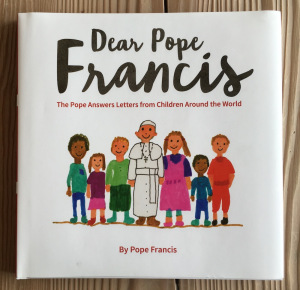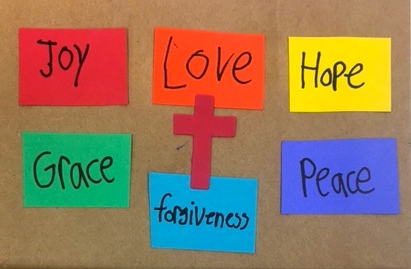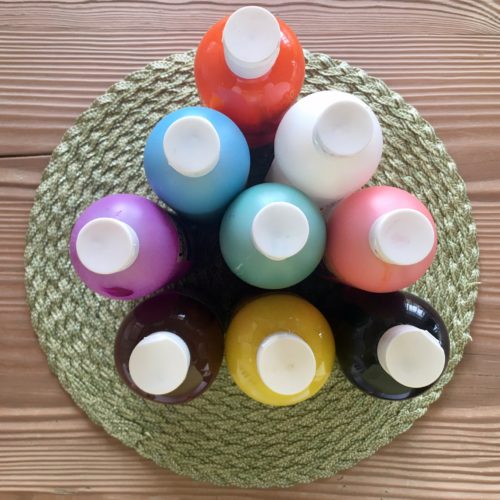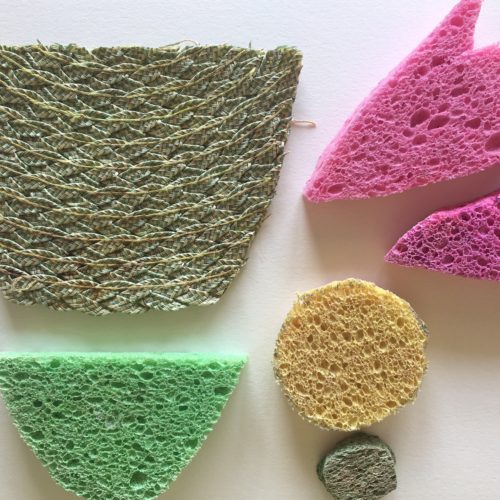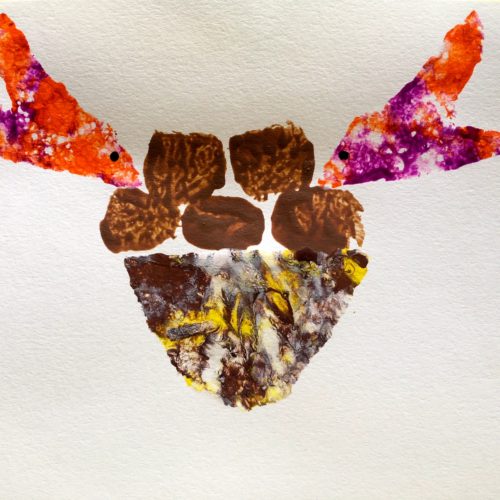“Jesus is God, and so he can do anything! He can walk safely on water. God cannot sink, you know!” Pope Francis in Reply to Natasha, Age 8
Source: Dear Pope Francis Pages 8-9
“Dear Pope Francis, I would like to know more about Jesus Christ. How did he walk on water?” Natasha, Age 8, Kenya
“Dear Natasha, You have to imagine Jesus walking naturally, normally. He did not fly over the water, or turn somersaults while swimming. He walked as you walk! He walked one foot after the other, as if the water were land. He walked on the water’s surface as he saw fish under his feet frolicking or racing around.” From Pope Francis
For Families to Share Together:
Pray the Rosary with your children. Use the Rosary crucifix to cross yourselves:
Just by chance last week, I saw a portion of “How to Pray the Rosary” of EWTN. The small part that I saw was so helpful. The speaker, Dr. Edward Sri, stated that there was a “hinge” between the first portion of “Hail Mary” and “Holy Mary” and that the hinge is the name “Jesus.” He suggested that we give the name of Jesus special attention and that we could reflect on one of the Mysteries, when we say His name. I have been using this technique and it makes a huge difference in giving this prayer the depth and reverence it deserves.
How to Pray the Rosary Source: Catholic Child’s Prayer Book By Rev. Thomas J. Donaghy St. Joseph Junior Books, Page 15 “We begin the Rosary with the sign of the Cross (for this is the way that we begin all of our prayers.) After this, we pray the Apostles’ Creed. This is a very ancient prayer that proclaims the important truths of our faith. After the Apostle’s Creed, we pray one Our Father, three Hail Marys and one Glory Be. Now we come to the most important reason we pray the Rosary: to meditate on the Mysteries of our Faith. We proclaim each of the five Mysteries, followed by one Our Father, ten Hail Marys, and one Glory Be. Remember, the reason for praying the Rosary is not to tally how many prayers we can say. It is to meditate on God’s love as shown in the lives of Jesus and Mary. This is why we hold the Rosary while we pray, so that we can keep track of the number of prayers we have said.”
Learn the five Luminous Mysteries, “Mysteries of Light: THE BAPTISM OF THE LORD, THE WEDDING OF CANA, THE PROCLAMATION OF THE KINGDOM, THE TRANSFIGURATION, and THE INSTITUTION OF THE EUCHARIST.”
The Apostles’ Creed from Catholic Online
Happening This Week
November 13 Saint Frances Xavier Cabrini’s Story Source: FranciscanMedia.org
“Frances Xavier Cabrini was the first United States citizen to be canonized. Her deep trust in the loving care of her God gave her the strength to be a valiant woman doing the work of Christ.”
“Refused admission to the religious order which had educated her to be a teacher, she began charitable work at the House of Providence Orphanage in Cadogno, Italy. In September 1877, she made her vows there and took the religious habit.”
“In 35 years, Frances Xavier Cabrini founded 67 institutions dedicated to caring for the poor, the abandoned, the uneducated and the sick. Seeing great need among Italian immigrants who were losing their faith, she organized schools and adult education classes.”
November 18 Dedication of the Churches of Saints Peter and Paul in Rome, Italy
Source: FranciscanMedia.org
“St. Peter’s is probably the most famous church in Christendom. Massive in scale and a veritable museum of art and architecture, it began on a much humbler scale. Vatican Hill was a simple cemetery where believers gathered at Saint Peter’s tomb to pray.”
The official name is The Papal Basilica of St. Peter in the Vatican, or Saint Peter’s Basilica.
“St. Paul’s Outside-the-Walls stands near the Abaazia delle Tre Fontane, where Saint Paul is believed to have been beheaded. The largest church in Rome until St. Peter’s was rebuilt, the basilica also rises over the traditional site of its namesake’s grave.”
The official name is The Papal Basilica of St. Paul outside the Walls, or Saint Paul’s Outside-theWalls.
Please Click Here to See Connie’s Photos from The Churches of Saints Peter and Paul
We Learn Through Storytelling
Have you read the story of Jesus reviving a young girl after she had died? It is called “Jairus’ Daughter” and can be found in Mark 5:21-43, as well as in most Catholic Bibles for children. According to Catholic Book of Bible Stories for Children, the story goes as follows:
A Paraphrased Excerpt from Pages 128-130
Jesus had been on a boat and wherever he went he drew large crowds who wanted to hear him and be near him. An official from the synagogue named, Jairus, approached Jesus to ask for help in healing his twelve-year-old-daughter who was seriously ill. A member of Jairus’ family ran up to him to tell him the sad news that his daughter had died. Jesus heard the news and said to Jairus, “Do not give up on your daughter. Have faith.” Together, Jesus and Jairus went to Jairus’ home to find relatives weeping over the girl’s death “Jesus said, ‘Why are you crying? The girl is sleeping.'” All the relatives mocked Jesus and told him to leave. “Jesus took the girl’s hand and said, ‘Child, get up!’ The girl immediately woke up. Her parent’s couldn’t believe their eyes.” All the people were in awe of this miraculous act performed by Jesus.
Jesus taught people in many ways–through telling stories called parables; through healing the sick and raising the dead, by walking on the sea during a storm, and by providing food and wine at times when there was none available. The story of “Fishes and Loaves” or “Jesus Feeds Five Thousand” is a story of a miracle. Here is the link to the story on USCCB.org.
A Paraphrased Excerpt from Pages 132-134
Jesus again was out speaking to thousands of people and healing the sick who had come to him for help. The disciples told Jesus to send the people home so they could eat. Instead, Jesus said to the disciples, “You feed the people.” A child brought a basket filled with two fish and five loaves of bread. “Jesus said, ‘Bring the food to me.'”
Here is what he did:
“Jesus took the five loaves and two fish and looked up into the heavens. He blessed the bread and broke it into pieces. He gave the pieces to his disciples. The disciples gave food to the crowd. It was a miracle!” Everyone ate and the food multiplied to be able to feed more than 5000 people. The people wanted to follow Jesus and learn from him wherever he went.
(Does this remind you of something you have heard before?)
For more easy- to- understand stories about the many ways Jesus helped and taught people, read The Miracles of Jesus by Katherine Sully, Illustrated By Simona San Filippo. Even though it is written for younger children, independent readers will enjoy the visual learning provided by the illustrations.

We Learn Through Reading
Psalm 150 “Praise God” Source: Page 77 in Catholic Book of Bible Stories
“Praise the Lord!
Praise God in his temple!
Praise his strength in heaven!
Praise him for the mighty things he has done.
Praise his supreme greatness.
Praise him with trumpets.
Praise him with harps and lyres.
Praise him with drums and dancing.
Praise him with harps and flutes.
Praise him with loud cymbals.
Praise the Lord, all living creatures!
Praise the Lord!”
We Learn Through Writing
As we approach Thanksgiving, then Advent on December 3, ask the children to write words, relating to Jesus, that express gratitude and appreciation.
We Celebrate Through Song
“Faith as Small as a Mustard Seed” (Text Written on Video)
We Celebrate Though Art

Art for “The Multiplication of the Loaves” also called, “Fishes and Loaves”
Click on images to enlarge.
Help your children visualize the miraculous story of Jesus feeding the masses fishes and loaves of bread and remember the five loaves and two fish. I use sponges cut into desired shapes, dipped in washable paint squirted onto a plate, then pressed onto paper. I used two sizes of sponges, and cut a frayed place mat into a basket shape to use as a stamp. For a simple painting of sponge art, use the small set of sponges. To give some depth to the basket, fish, and loaves paintings made by the bigger materials. Let dry, then cut them out. Glue them in your desired pattern, onto paper. I put a heavy tray on top to press the cut-outs down. Then I put the white sheet of paper with the glued painted shapes onto a sheet of vibrant colored paper. Have fun. This can be messy but clean-up is easy with washable tempera paint.


